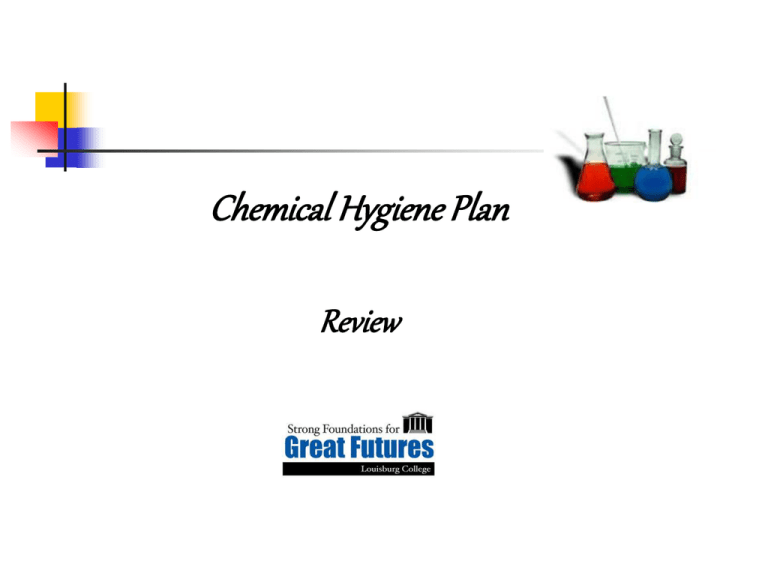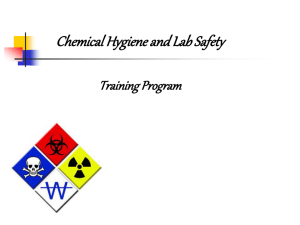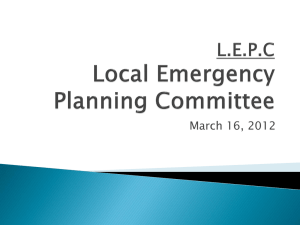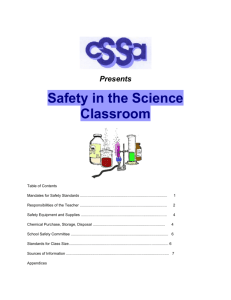Chemical Hygiene Plan Review
advertisement

Chemical Hygiene Plan Review Chemical Hygiene Plan CHP Review Objectives Reduce chances for lab accidents Avoid unnecessary exposure Regulation compliance General Awareness Chemical Hygiene Plan Understanding MSDSs Overview o o o o o o o o General Rule and Procedures Standard Operating Procedures (SOPs) Housekeeping procedures Choosing Hazardous Chemicals Labeling, Storage, and Disposal Material Safety Data Sheets (MSDSs) Protective Clothing Requirements Emergency Procedures CHP Review shall occur: In advance of laboratories Prior to new tasks involving hazardous chemicals Information and Training General Awareness Campus Preparation Locate Chemical Hygiene Plan Contains specific hazards, SOP’s, potential exposures, and protective measures Refer all safety questions to Science Lab Director Employee Review Record – Maintained on file Purpose and Policy Purpose: Ensure that the hazards are evaluated Convey information to lab supervisors Policy: Employees are entitled to a safe and healthy place to work, and Have a right to know what you may be exposed to and how to protect yourself Responsibilities Develop and implement a written Chemical Hygiene Plan (CHP) Inventory all hazardous materials in Department and acquire all related Material Safety Data Sheets (MSDSs) Identify hazards by labeling chemicals Train employees on physical and health hazards and protective measures Employee Responsibilities o Follow all procedures and policies relating to chemicals and follow appropriate laboratory procedures and rules as outlined in the CHP o Refrain from lab operations without proper preparation o Seek out and request information o Wear appropriate protective equipment o Report accidents and near-misses immediately, even minor injuries or exposures to the Lab Director Administrative Controls Chemical Hygiene Coordinator Duty assignment Science Lab Director Ensure lab supervisors know their responsibilities under the Chemical Hygiene Plan Operational Controls Basic Standard Operating Procedures Information Dissemination and Inspections Basic Standard Operating Procedures Rules and procedures Safety Rules and guidelines Chemical procurement, storage and inventory procedures Spill and accident procedures Personal protection apparel and equipment Information dissemination, documentation Emergency response Specific Standard Operating Procedures Included and specific to each lab procedure No required format or delivery Required content: Hazard controls Personal protective equipment Health & safety information Decontamination & waste disposal procedures Engineering Controls Fume Hoods Biosafety Cabinets Less hazardous Substitution “Other” Control Measures Protective Equipment Safety Equipment Respirators, goggles, gloves, lab coats Safety showers, eyewashes, fire extinguishers, first aid kits, Laboratory Maintenance and Inspection Safety inspections, fume hood condition, chemical storage, spill kits, etc. Exposure Assessments Policy on monitoring Signs or symptoms of overexposure You suspect exposure limits have been exceeded Determined & carried out by First Responders Regulated Waste Management Wastes Considered Non-Hazardous Listed/Hazardous Medical Waste Universal Hazardous Chemical Inventories An inventory of chemicals on hand is required. Hazardous Chemicals Locations On Campus May Include: Hazardous Chemicals In Laboratories May Consist Of: Corrosives - Nitric Acid Oxidizers - Silver Nitrate General Organic Compounds - Aniline Caustics - Calcium Oxide Reactive Metals - Sodium Explosive Anhydrides and Anhydrous Compounds Sodium Peroxide Ketones - Acetone Poisons - Potassium Cyanide General Inorganic Compounds - Calcium Carbide Flammable Metals Magnesium Flammables - Ethanol, Butanol, Ethyl Ether Carcinogens Formaldehyde Hazard Communication Color coded system Labels - Basics Identity of the hazardous chemical(s) chemical label is your primary source of information regarding the product. Appropriate hazard warnings Labels & Other Information Appropriate personal protective equipment Signal word - Danger!, Warning!, or Caution! Statement of hazard Instructions in case of contact or exposure First-Aid or antidote Instructions in case of fire, spill, or leak Instructions for container handling and storage Never remove label, and if transferred to a secondary container, label the bottle (not the lid) with appropriate information - chemical name, etc. HMIS Label - Example Secondary Labeling System Labels- Symbols and Pictures Material Safety Data Sheets (MSDS’s) Chemical document put out by manufacturer detailing physical and health hazards One for every hazardous chemical on campus Master file located in Lab Directors office Review before working with any chemical Information on MSDSs Identity and date of preparation Manufacturer’s name, address, and telephone number Hazardous ingredients Physical and chemical properties - flash pt., appearance and odor, etc. Information on MSDSs Control measures Physical hazards Routes of entry into body Acute and chronic health effects Carcinogenicity Handling and storage precautions Chemical Sensitivities Some hazardous chemicals are used Immune responses and sensitivities can vary among individuals Low-dose exposures over longer periods of time can alter function of immune system Chemical Sensitivities Effects may develop slowly Symptoms may include Multiple Chemical Sensitivities, Contact Dermatitis Examples include – nickel compounds, amines, epoxides, some organic solvents Protective Measures Routes of entry Inhalation Ingestion Skin or eye contact, and/or absorption Exposure = Dose x Duration Protective Measures Avoid Inhalation Use proper ventilation (Fume Hood) Use respiratory protection (Respirator) Check MSDS for specific requirements Protective Measures Prevent Ingestion NO eating, drinking, smoking, or applying cosmetics in labs Wash hands frequently Label everything Read labels and MSDSs Protective Measures Prevent Skin or Eye Contact Wear protective equipment Minimize the area of exposed skin Protective Measures - Review Avoid Inhalation Use proper ventilation Use respiratory protection when needed Prevent Ingestion No eating, drinking, smoking, or apply cosmetics in labs Wash hands frequently Protective Measures - Review Prevent Skin or Eye Contact Wear protective equipment Minimize the area of exposed skin Handle With Caution Use cautious approach Read labels, follow their directions Think about consequences Treat all substances as if they are hazardous Practice good chemical hygiene Emergency Procedures Chemical Spills Evacuate and call Public Safety at 911 for larger spill (>1-gallon) situations Treat life threatening injuries immediately Contain the spill – refer back to MSDS Wear protective equipment during clean-up Best response is preparation Emergency Procedures Personal Contamination Flush contaminated area with water Remove contaminated clothing Rinse with water for 15 minutes Seek medical attention if irritation persists Emergency Procedures Chemical in the Eye(s) Flush eyeballs and inner eyelids Forcibly hold eyes open Irrigate for at least 15 minutes Seek medical attention immediately Summary You may be exposed to hazardous chemicals or chemicals products used on campus Information is available on labels and MSDSs A CHP is in place in your work area to inform you Chemical Hygiene Review Certification Form By signing below you acknowledge that you are aware of the Chemical Hygiene Plan. I: know where the Workplace Chemical List/Chemical Inventory is located and understand its purpose. know how to interpret labels and MSDSs. know where the Department MSDSs are located. understand the protective measures, first aid procedures and emergency procedures necessary for the chemicals I use. know that the Hazardous Materials Safety Manual is available in the Lab Directors office. understand that there are special procedures and requirements for managing chemical and hazardous waste and that these materials must not be poured down the drain or placed in the regular trash. understand that the Occupational Safety and Health Administration (OSHA) requires that laboratory workers be made aware of the Chemical Hygiene Plan (CHP) (29 CFR 1910.1450). Date Printed Name Signature









